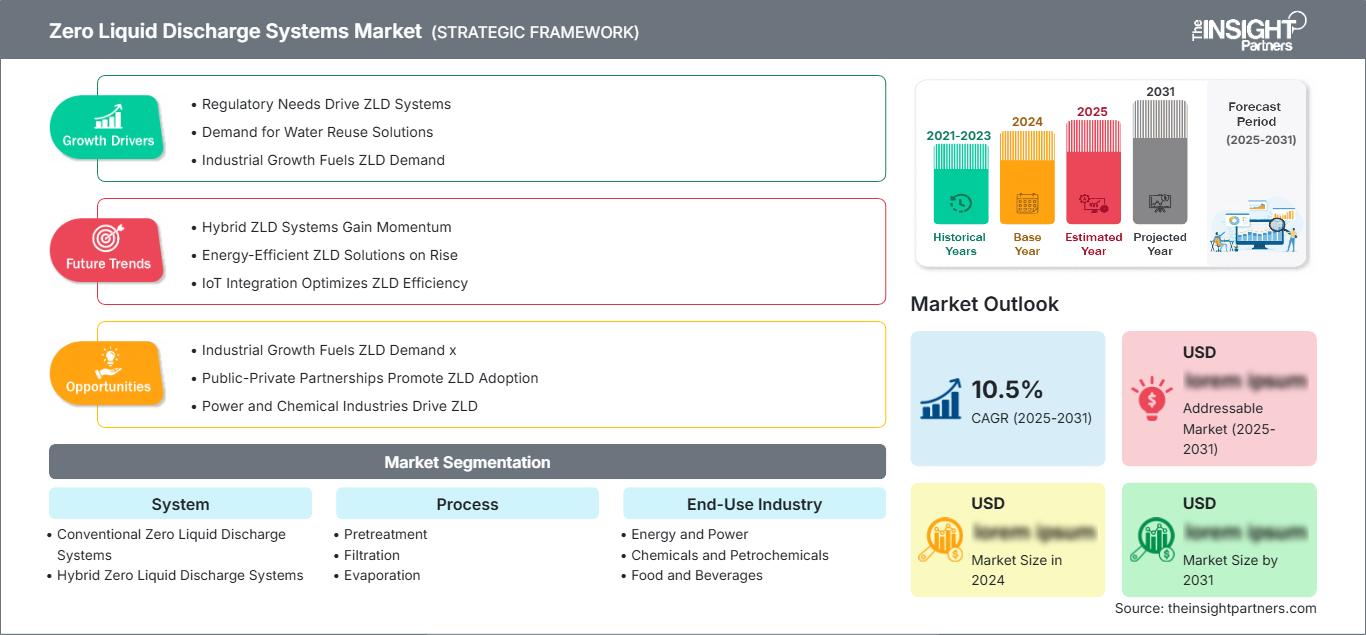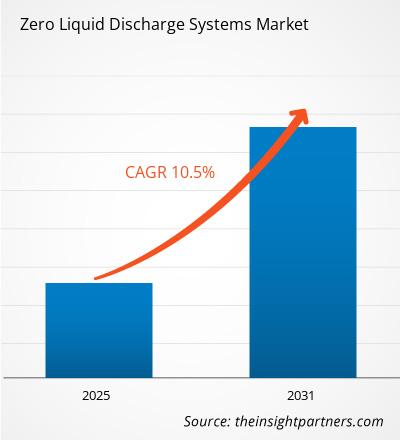Si prevede che il mercato dei sistemi a scarico zero di liquidi registrerà un CAGR del 10,5% dal 2025 al 2031, con una dimensione del mercato in espansione da XX milioni di dollari nel 2024 a XX milioni di dollari entro il 2031.
Il mercato è segmentato in base a sistema, processo e settore di utilizzo finale. Il segmento dei sistemi è suddiviso in sistemi convenzionali a scarico zero di liquidi e sistemi ibridi a scarico zero di liquidi. In base al processo, il mercato è segmentato in pretrattamento, filtrazione, evaporazione e cristallizzazione. In base al settore di utilizzo finale, il mercato è segmentato in energia ed energia, prodotti chimici e petrolchimici, alimenti e bevande, tessile, prodotti farmaceutici, semiconduttori ed elettronica, altri.
Scopo del rapporto
Il rapporto sul mercato dei sistemi a scarico zero di liquidi di The Insight Partners mira a descrivere il panorama attuale e la crescita futura, i principali fattori trainanti, le sfide e le opportunità. Ciò fornirà spunti a vari stakeholder aziendali, come:
- Fornitori/produttori di tecnologia: per comprendere le dinamiche di mercato in evoluzione e conoscere le potenziali opportunità di crescita, consentendo loro di prendere decisioni strategiche informate.
- Investitori: per condurre un'analisi completa delle tendenze in merito al tasso di crescita del mercato, alle proiezioni finanziarie del mercato e alle opportunità esistenti lungo la catena del valore.
- Organismi di regolamentazione: per regolamentare le politiche e le attività di controllo nel mercato con l'obiettivo di ridurre al minimo gli abusi, preservare la fiducia degli investitori e sostenere l'integrità e la stabilità del mercato.
Sistema di segmentazione del mercato dei sistemi a scarico zero di liquidi
- Sistemi convenzionali a scarico zero di liquidi
- Sistemi ibridi a scarico zero di liquidi
Processo
- Pretrattamento
- Filtrazione
- Evaporazione
- Cristallizzazione
Industria di utilizzo finale
- Energia ed energia
- Prodotti chimici e petrolchimici
- Alimenti e bevande
- Tessili
- Prodotti farmaceutici
- Semiconduttori ed elettronica
- Altri
Geografia
- Nord America
- Europa
- Asia-Pacifico
- America meridionale e centrale
- Medio Oriente e Africa
Potrai personalizzare gratuitamente qualsiasi rapporto, comprese parti di questo rapporto, o analisi a livello di paese, pacchetto dati Excel, oltre a usufruire di grandi offerte e sconti per start-up e università
Mercato dei sistemi a scarico zero di liquidi: Approfondimenti strategici

-
Ottieni le principali tendenze chiave del mercato di questo rapporto.Questo campione GRATUITO includerà l'analisi dei dati, che vanno dalle tendenze di mercato alle stime e alle previsioni.
Fattori di crescita del mercato dei sistemi a scarico zero di liquidi
- Pressione normativa per la conformità ambientale: l'aumento delle normative volte a ridurre gli sprechi industriali e a promuovere pratiche sostenibili sta spingendo l'adozione di sistemi a scarico zero di liquidi (ZLD). Governi e agenzie ambientali stanno applicando linee guida più severe sulla gestione delle acque reflue, costringendo le industrie a implementare soluzioni ZLD per ridurre al minimo il loro impatto ambientale.
- Carenza idrica e gestione delle risorse: la crescente preoccupazione per la scarsità idrica è un fattore determinante per il mercato ZLD. Poiché le industrie cercano di ottimizzare l'utilizzo dell'acqua e ridurre la dipendenza dalle fonti di acqua dolce, i sistemi ZLD offrono una soluzione efficace riciclando e riutilizzando l'acqua, migliorando così la gestione complessiva delle risorse idriche.
Tendenze future del mercato dei sistemi a scarico zero di liquidi
- Integrazione di tecnologie intelligenti: la tendenza verso l'automazione e le tecnologie intelligenti sta influenzando il mercato ZLD. L'integrazione dell'IoT e dell'analisi dei dati nei sistemi ZLD consente il monitoraggio e l'ottimizzazione in tempo reale dei processi di trattamento delle acque. Questa tendenza migliora l'efficienza operativa e aiuta le industrie a raggiungere una migliore conformità alle normative ambientali.
- Focus sulle pratiche dell'economia circolare: l'attenzione ai principi dell'economia circolare all'interno delle industrie è sempre più rivolta, promuovendo il riutilizzo e il riciclo delle risorse. I sistemi ZLD si allineano bene a questa tendenza consentendo il recupero di materiali preziosi dalle acque reflue e riducendo la produzione di rifiuti. Questo passaggio alla sostenibilità sta alimentando l'interesse per le soluzioni ZLD in diversi settori.
Opportunità di mercato per i sistemi a scarico zero di liquidi
- Progressi tecnologici: le tecnologie ZLD offrono notevoli opportunità di innovazione. Lo sviluppo di sistemi ZLD più efficienti ed economici può attrarre una gamma più ampia di settori, compresi quelli che sono stati esitanti ad adottare tali tecnologie a causa dei costi di investimento iniziali. Le innovazioni nella tecnologia delle membrane, nei processi di cristallizzazione e nei sistemi di recupero energetico possono aumentare l'attrattiva delle soluzioni ZLD.
- Espansione nei mercati emergenti: le economie emergenti stanno riconoscendo sempre più l'importanza di pratiche di gestione sostenibile delle risorse idriche. Ciò rappresenta un'importante opportunità per i fornitori di sistemi ZLD di entrare in questi mercati, dove la crescita industriale è accompagnata da crescenti preoccupazioni ambientali. La personalizzazione delle soluzioni per soddisfare le esigenze specifiche di queste regioni può portare a una sostanziale crescita del mercato.
Approfondimenti regionali sul mercato dei sistemi a scarico zero di liquidi
Le tendenze regionali e i fattori che influenzano il mercato dei sistemi a scarico zero di liquidi durante il periodo di previsione sono stati ampiamente spiegati dagli analisti di The Insight Partners. Questa sezione illustra anche i segmenti di mercato e la geografia dei sistemi a scarico zero di liquidi in Nord America, Europa, Asia-Pacifico, Medio Oriente e Africa, America meridionale e centrale.
Ambito del rapporto di mercato sui sistemi a scarico zero di liquidi
| Attributo del rapporto | Dettagli |
|---|---|
| Dimensioni del mercato in 2024 | US$ XX million |
| Dimensioni del mercato per 2031 | US$ XX Million |
| CAGR globale (2025 - 2031) | 10.5% |
| Dati storici | 2021-2023 |
| Periodo di previsione | 2025-2031 |
| Segmenti coperti |
By Sistema
|
| Regioni e paesi coperti |
Nord America
|
| Leader di mercato e profili aziendali chiave |
|
Densità degli operatori del mercato dei sistemi a scarico zero di liquidi: comprendere il suo impatto sulle dinamiche aziendali
Il mercato dei sistemi a scarico zero di liquidi è in rapida crescita, trainato dalla crescente domanda degli utenti finali, dovuta a fattori quali l'evoluzione delle preferenze dei consumatori, i progressi tecnologici e una maggiore consapevolezza dei vantaggi del prodotto. Con l'aumento della domanda, le aziende stanno ampliando la propria offerta, innovando per soddisfare le esigenze dei consumatori e sfruttando le tendenze emergenti, alimentando ulteriormente la crescita del mercato.

- Ottieni il Mercato dei sistemi a scarico zero di liquidi Panoramica dei principali attori chiave
Punti di forza
- Copertura completa: il rapporto analizza in modo esaustivo prodotti, servizi, tipologie e utenti finali del mercato dei sistemi a scarico zero di liquidi, fornendo un panorama olistico.
- Analisi degli esperti: il rapporto è redatto sulla base della conoscenza approfondita di esperti e analisti del settore.
- Informazioni aggiornate: il rapporto garantisce la pertinenza aziendale grazie alla copertura di informazioni e tendenze dei dati recenti.
- Opzioni di personalizzazione: questo rapporto può essere personalizzato per soddisfare le esigenze specifiche del cliente e adattarsi in modo appropriato alle strategie aziendali.
Il rapporto di ricerca sul mercato dei sistemi a scarico zero di liquidi può quindi contribuire a guidare il percorso di decodificazione e comprensione dello scenario del settore e delle prospettive di crescita. Sebbene possano esserci alcune preoccupazioni valide, i vantaggi complessivi di questo rapporto tendono a superare gli svantaggi.
- Analisi storica (2 anni), anno base, previsione (7 anni) con CAGR
- Analisi PEST e SWOT
- Valore/volume delle dimensioni del mercato - Globale, Regionale, Nazionale
- Industria e panorama competitivo
- Set di dati Excel
Report recenti
Testimonianze
Motivo dell'acquisto
- Processo decisionale informato
- Comprensione delle dinamiche di mercato
- Analisi competitiva
- Analisi dei clienti
- Previsioni di mercato
- Mitigazione del rischio
- Pianificazione strategica
- Giustificazione degli investimenti
- Identificazione dei mercati emergenti
- Miglioramento delle strategie di marketing
- Aumento dell'efficienza operativa
- Allineamento alle tendenze normative






















 Ottieni un campione gratuito per - Mercato dei sistemi a scarico zero di liquidi
Ottieni un campione gratuito per - Mercato dei sistemi a scarico zero di liquidi